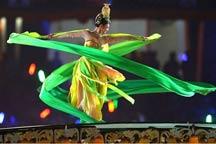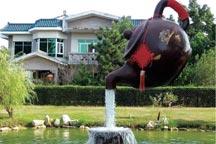On this episode of Travelogue, the world's highest plateau, the most mysterious people. With a long, unique history, meet the brave and devout, Tibetans in Tibet.
Variety of its landscape and diversity of its people, welcome to Travelogue’s Ethnic Minority Special. If you think about the minorities of China, perhaps the most mysterious of all are the Tibetans. And that’s why today we are in Tibet. This place right now is actually the birthplace of Tibetan culture. These mountains, this plateau, everything around me is where it happened originally. So, get ready for the adventure of a lifetime. Welcome to Travelogue, I’m Yin.
For most people, a journey to the Tibet Autonomous Region is a fantasy – something beyond their reach. For others, it’s a lifelong dream that may just come true. And for yet others, it’s a mission that defines their very existence.
We’ll be drifting downstream on the Ya3long2 River from the birthplace of Tibetan civilization, Shannan, as far as Linzhi, and onwards to the heart of Tibet, the capital Lhasa.
We’re accompanied on our journey to Lhasa by tourists and Buddhists. Tibet, with its average altitude of 4000 meters, is called the roof of the world. Everyone who travels here has their own unique reasons for doing so – from exploring the unknown to attaining enlightenment.
Religion is the foundation of traditional Tibetan culture.
Buddhism first came to the region during the reign of Songtsan Gambo in the 7th century. In the Tubo kingdom, he laid the foundation for Buddhism by importing scriptures and building monasteries. His other great achievement was to cement the ties between the Han and Tibetan peoples, which he did by marrying the Tang Dynasty princess, Wencheng.
Today, Tibetans live in a land where past and present merge. From traditional yak butter tea to international fare, religious paintings to postmodern art, it’s a bizarre mix unlike any other. But one ting that’s never changed over the years is the spirit of the people.
In Shannan – the ancient birthplace of Tibetan culture – there stands the first palace built by the first Tibetan king. That was in the second century BC. The Yumbu Lhakang Palace is the oldest surviving example of Tibetan architecture.
Look at the crops over here. These are the lands the first Tibetans settled over 2000 years ago. It’s believed they came here, had a Tibetan king, and built the first palace. Perhaps that’s why this area is so sacred.
Legend has it that the original ancestors of the Tibetans were a sacred monkey and a mortal woman. Over the centuries, their descendants multiplied and formed a tribe, and they turned the valley into agricultural land.
After the first king descended to Earth from the Heavens, he was followed a little later by the first sacred texts, which fell on the roof of his palace.
Buddhism made its way into Tibet from India. The central figure in Buddhism – and its founder – is Sakyamuni.,
Still today, a sign of devotion among Buddhists is to recite the sutras, spin prayer wheels, and offer yak’s butter for the oil lamps in the monasteries.
The Yumbu Lhakang Palace, geometric in shape, was the model based on which many other structures were later built. There’s something magical about the towering palace, perched on the mountain, beneath the clouds and brilliant sun. It’s actually impossible to describe.
Tibetans live in compact communities on the Tibetan Plateau, making up 95% of the population. The natural environment is harsh, temperatures are cold, oxygen is deficient, and vegetation is scarce. For these farmers and herdsmen, the most important crop is barley, and dough made from barley flour, is the staple food of Tibet.
This site, covering almost four million square meters, is the celebrated tomb of the Tibetan kings. Among those buried here are Songtsan Gambo himself, along with his wives and concubines. The tombs are flat on the top and piled with earth and rocks. There are believed to be 20 of them in total, although not all have been found.
Tibetans live in an area with an extensive river system and vast lakes. Naturally, they have learned to use these waterways as a means of transport. By tradition small boats made of animal hide were used to cross the rivers. Although today’s boats are a bit more sophisticated, the journey is no less difficult.
After about 20 minutes, we’re stuck in the middle of the river because surprisingly, the river is not deep enough. This man is pushing us over because the sand is stuck underneath and we’re slowly gravitating this way and hopefully get on the right path soon.
Discovering the hidden wonders of Tibet is a real challenge. You’ll need a car and a boat, along with some rather more strange-looking vehicles; and not forgetting your own two feet, of course. Dust, bright sunshine, and the unpredictable weather all add to the difficulties. But an adventurous spirit and some endurance are usually enough to open up a world beyond your imagination.
To get to this very old and traditional monastery, I think the most sacred journeys ever. It’s said all Tibetans in their lifetime have to go to this temple. Some go by horse, by foot, on this thing, and even prostrating. They bow down on their hands and knees and walk over. It’s quite a journey.
Samye Monastery, built in the 8th century, was the first monastery in Tibet. It was commissioned by an Indian Buddhist master. It combines elements of Han, Tibetan and Indian architecture, and because of this it’s called the "three-style temple". It’s one of the most popular destinations for pilgrims, some of whom travel on foot for weeks to reach it.
The ground floor is Tibetan in style, the middle floor is Han, and the top is Indian.
Samye monastery is particularly famous for its grand scale and its position as the oldest and earliest monastery containing all three religions. The name in English translates into the “unimaginable monastery.” That’s because when it was first being built, it was unimaginable how huge this place was. After it was constructed, it was being taken down by the demons every night. But somehow, miraculously, it still came to be what it is today.
An air of mystery surrounds Samye Monastery, enhanced by its grandiose and complex design. It’s supposed to replicates the universe, as described in the sutras. Four towers, each of a different color, stand at the four angles of the main temple hall. They symbolize the Four Heavenly Kings, who are said to protect and bless the monastery.
The monastery’s interior is large and colorful. It’s a place where many monks come to study. But there’s one room we’re not allowed to see. It’s where monks of the highest standing spend three years studying the scriptures – and they don’t come out until their time is up. Food is delivered to them daily.
Here the wall paintings are most informative. For instance, this one displays the rules of the monastery. It seems they’re very particular about the types of shoes allowed inside. This is the type of kettle used for carrying holy water, these are the rules for praying.
A daily ritual for monks is debating the Buddhist scriptures. It’s a way for the novices to learn. The debate also serves as a test, by which a ranking can be drawn up, of how much the monks have mastered the rules of the Buddha.
A must for all Tibetans is to make a trip to this temple and come here. You must pray infront of this door. This door is supposed to be the gateway to heaven. If you look inside this hole, you’ll see your future.
Tibetans from all over the world will come here. And they always leave a personal token. Sometimes it’s a picture, sometimes it’s something written; or it may be something of more practical use. Beside the door hang two leather bags. Visitors leave a hair in one of them, as a token that they have reserved their place on the path to heaven. For Tibetans, death is not something to be feared. Rather like life, it’s a process to be experienced and passed through.
Next we head to Linzhi in the southeast of Tibet, where the altitude is 3000m. At this milder climate, we find unique greenery of southern Tibet.
The land here is nurtured by the Ni2yang2 River, a branch of the ya2lu3zang4pu3. The scenery is beyond the imagination of anyone who’s not seen it – forests, rich vegetation, and small villages nestling among snow-capped mountains. A holy lake, Ba1song1cuo4, is found here, whose waters give a reflection as good as any mirror’s. Legend has it that once two young lovers, who were unable to be together in life, dived into the lake – and in doing so they made it even more beautiful.
The area is famous for its picturesque communities. I visited Walnut Village, so named because of the walnut trees that surround it. It’s just the place to get a glimpse of what Tibetan life is really like.
I guess we’ve seen many types of prayer wheels, those spun by hand, by the wind, and now one spun by water power. Each time it spins, it’s like reading the scriptures.
Spinning the prayer wheel is believed to spread spiritual blessings and well-being. But there are different ways of doing it. Water is also used to power the local barley mill to make the staple food here, `tsamba'. After the barley is ground into very fine flour, it’s mixed with a little tea and then rolled into small lumps and eaten with fingers. It’s as important to them as are rice and bread to us.
The high mountains, combined with the deep valleys and cold temperatures, makes transportation inside Tibet particularly difficult. On the plateau, people ride on sure-footed yaks; on the waters, they ride in boats made of animal hide. Anyway, in Tibet there is what you might call a strong “Yak culture.”
So here comes my taxi. A special seat for me, too. This traditional means of transportation is what Tibetans mostly use to cross streams like this one and the grand rivers. It’s hard to believe that something made of wood and cow’s hide can hold something like myself down the water. Can’t buckle up here, so you gotta hold on tight and lie life like a real Tibetan.
From Linzhi we continue on to Lhasa, the heart of Tibet, and for centuries a destination for Buddhist pilgrims. Still today, people head to Lhasa in their droves – by bike, by road vehicle, and even on hands and feet. The journey can take weeks or even months. Incidentally, Lhasa in Tibetan means “place of god.”
Lhasa is famous for the Potala Palace and the Jokhang monastery, which are in the center of the old city. The religious influence is very strong, and every year the city really comes alive during the Shoton Festival, when thousands upon thousands of people gather.
I got up at 3AM this morning to get in line for the festival, climbed up the mountain for half an hour. Finally my turn to get a ticket.
An important part of Shoton Festival is to visit the giant painting of the Buddha above Drepung Monastery. People start climbing the mountain as early as 2am, in order to get the best view.
Slowly, the first glimmer of light smiles upon the land; and on a city with more than 1,400 years of history.
Songtsan Gambo moved his capital to Lhasa from Shannan in the 7th century. According to historical records, he built the city specially for the Tang Dynasty princess he married, Princess Wencheng. For her part, she brought a statue of Sakyamuni to Lhasa with her, and the Jokhang Monastery was built to house it. This effectively made the Jokhang Monastery the heart of the city. Today, it is still its spiritual centre.
But today near Drepung Monastery, we are soon enveloped in mulberry smoke, as well as the sound of horns and of scriptures being recited. A group of lamas, over a hundred of them, are pull the 30-metre painting up to a platform.
Originally, the festival was purely religious. Monks would spend weeks in retreat. When they emerged, it was the custom for commoners to give them yogurt. Hence the festival’s name Shoton, meaning Yogurt.
And so the giant picture of Sakyamuni is revealed.
Devout Tibetans will offer hada – a white silk cloth , a symbol of purity and devotion– and walk around the mountain, hoping to be blessed.
To all Tibetans, this is a magical moment. A special connection is formed that nobody has ever fully explained, but can, they say, be felt rooted in their hearts, rooted in their unique world. As for us outsiders; well, we can almost breathe it in the air.
In the afternoon, the activities move to the Luo2 bu4 Lin2 ka3. Tibetans are traditionally a nomadic and herding people, and many families will camp out here for a few days, chatting with friends, eating yogurt, and watching the traditional opera. Living in tents is a must– as is plain to see during the holidays.
Tibetans live in vastly different styles. In the high-altitude North, there are no trees so the nomadic people live in tents. In farming communities, they live in mud brick houses. In southeast Tibet, they live in wood homes, and in Lhasa, they live in modern homes.
In general, Tibetan festivals have a strong ethnic and religious flavor. Ideology of people in this land differs greatly from others, doing good deeds and collecting merit, living for the next life, rather than for the present.
The families sing songs that tell of their history and past. On this festive occasion, Tibetans dressed in their best, will gather together and watch the Tibetan opera, which is based on Buddhist teachings and Tibetan history. It is so important to their culture that the name for Shoton festival is also known as Tibetan Opera Festival. The performances last for about a week during the holidays. Tibetan opera dates back fourteen hundred years, almost to the dawn of Tibetan civilization.
The traditional drama is a combination of dances, chants, songs, and masks.
They’re all in their costumes and masks. If I’m not mistaken, since I don’t know what they are saying, it seems like they are performing one of their legends or stories.
To an outsider, Tibet can seem inscrutable, and rather distant. However, its mystery and beauty never fail to leave an indelible impression on all those daring enough to come and look.
And there we have it. That is Tibet, the place where modernity and tradition blend together, a mix of past and present, a place where Tibetans lived, and many others came from all over the world. I’m Yin and see you next time on our special.
Tips:
The Tibetans are traditionally a nomadic people who reside on the Tibetan plateau, “the roof of the world”.
They are devout Tibetan Buddhists, whose lifestyles are heavily influenced by their religion.
The culture of the Tibetans is also shaped by the unique natural environment, which varies across the land, leading to regional differences.
 2009 China Central Television. All Rights Reserved
2009 China Central Television. All Rights Reserved

















